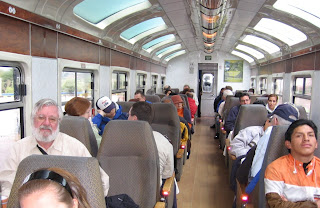Machu Picchu is about 133 km (83 miles) by train from Cusco. Two tourist trains make the trip, the Vista Dome, at $71 US each way is the most luxurious, but the Backpacker at $60 is also clean and comfortable. Other trains make the trip at considerably less cost (and comfort) but are open only to Peruvians. We went on the Vista Dome, but the 5:00 PM return was full, so we came back via the Backpacker to Ollantaytambo, and then by taxi to Cusco.
The Vista Dome climbed out of Cusco via four switchbacks, and then on to Ollantaytambo, where it paralleled the Rio Urubamba (previously the Rio Urubush?) to Aguas Calientes, the town below Machu Picchu.
The train ride was smooth, if slow, and the scenery was impressive, and the crew served breakfast.
From Ollantaytambo the track follows the river through the increasingly deep canyon. The Rio Urubamba is an incredible river, with class V+ rapids. Rafting trips are available.
From the end of the road west of Ollantaytambo, the “Inca trail,” departs for Machu Picchu. The 85 km trek, which can be taken only with guides, usually takes 4 days. Only 200 tourists (+ 300 guides, cooks, porters, etc.) can begin the trip each day and reservations are required well in advance…. like six months if you are traveling in the high season, May to September.

Inca sites and terraces are visible from the train.
 Aguas Calientes, at the end of the train ride, is dedicated entirely to tourism. Leaving the train one passes through a maze of artesanías (AKA gewgaw shops), and into the restaurant district. A block below is the bus station, where (for $14) one can buy a bus ticket to and from the site, and the office of Tourism, for an entry ticket ($40). The day in Machu Picchu, is expensive, $175 and up.
Aguas Calientes, at the end of the train ride, is dedicated entirely to tourism. Leaving the train one passes through a maze of artesanías (AKA gewgaw shops), and into the restaurant district. A block below is the bus station, where (for $14) one can buy a bus ticket to and from the site, and the office of Tourism, for an entry ticket ($40). The day in Machu Picchu, is expensive, $175 and up.  Here at the site entrance, guides were available. We engaged Jessica, a registered guide who had studied Inca archaeology and was very knowledgeable; able to answer questions as well as to recite the script. And very nice, as well.
Here at the site entrance, guides were available. We engaged Jessica, a registered guide who had studied Inca archaeology and was very knowledgeable; able to answer questions as well as to recite the script. And very nice, as well. The first stop on the tour is the hut of the guardian, from which the famous photos of the site, like the one at the beginning of this blog, are taken. Less obvious in most photos are the tourists, up to 2,500 per day in the high season. We were not in the high season, which meant clouds and occasional rain, but also fewer tourists.
The first stop on the tour is the hut of the guardian, from which the famous photos of the site, like the one at the beginning of this blog, are taken. Less obvious in most photos are the tourists, up to 2,500 per day in the high season. We were not in the high season, which meant clouds and occasional rain, but also fewer tourists.Plenty of tourists, but fewer than in the high season.
But rain and crouds notwithstanding, the site and setting are breathtaking and well worth the trip.
 Within the site, the stone work was most impressive in the ritually important areas; in others it was less finely detailed.
Within the site, the stone work was most impressive in the ritually important areas; in others it was less finely detailed.
Agricultural terraces on the non-residential areas of the site.

Alejandra and Jessica
After about two hours we returned to Aguas Calientes and almuerzo, and then back to Ollantaytambo via the Backpacker train, and then on to Cuzco. Then back to Lima and to Santiago.
The backpacker.
















































